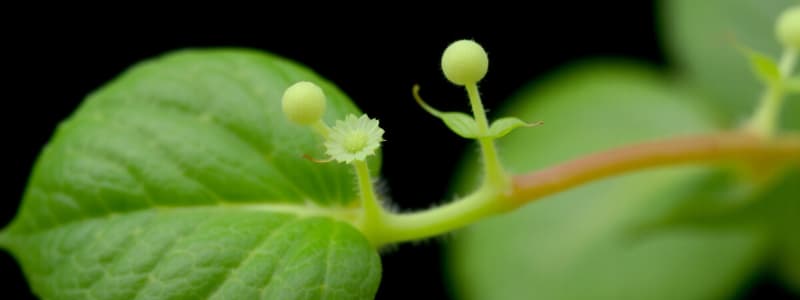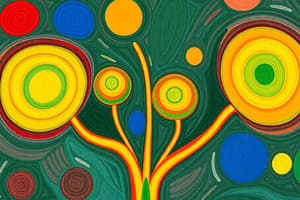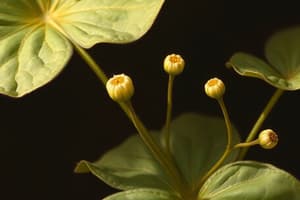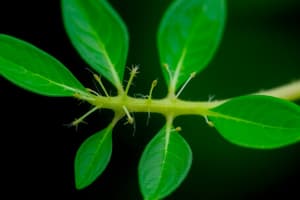Podcast
Questions and Answers
Which of the following accurately describes the relationship between cell structure and function in plant development?
Which of the following accurately describes the relationship between cell structure and function in plant development?
- The function of a cell determines its structure, but the structure has no bearing on the function.
- The structure of a cell, tissue, or organ is directly related to the function it performs, and this relationship can be altered during development. (correct)
- Cell structure and function are independent of each other.
- Cell structure dictates its function; altering the structure will not alter the cellular function.
What is the significance of seed germination in the context of plant growth and development?
What is the significance of seed germination in the context of plant growth and development?
- It only occurs in plants that are under stress and need to reproduce.
- It marks the end of the plant's life cycle.
- It is a period of suspended metabolic activity, preparing the seed for dormancy.
- It is the initial step in the process of plant growth, occurring when environmental conditions are favorable. (correct)
What is the primary reason plants can exhibit unlimited growth potential throughout their lives?
What is the primary reason plants can exhibit unlimited growth potential throughout their lives?
- The continuous supply of external nutrients from their environment.
- The presence of meristems, which contain cells capable of dividing and self-perpetuating. (correct)
- Efficient metabolic processes that prevent cell aging.
- The absence of a predetermined genetic limit.
What is the effect on a plant if its meristems cease to divide?
What is the effect on a plant if its meristems cease to divide?
In dicotyledonous plants and gymnosperms, what is the role of the vascular cambium and cork-cambium?
In dicotyledonous plants and gymnosperms, what is the role of the vascular cambium and cork-cambium?
Why is measuring protoplasm increase not typically used to quantify growth at the cellular level?
Why is measuring protoplasm increase not typically used to quantify growth at the cellular level?
Which of the following parameters is LEAST suitable for measuring growth in a dorsiventral leaf?
Which of the following parameters is LEAST suitable for measuring growth in a dorsiventral leaf?
During the meristematic phase of growth in root tips, what characteristics would you expect to observe in the cells?
During the meristematic phase of growth in root tips, what characteristics would you expect to observe in the cells?
In arithmetic growth, what occurs after mitotic cell division?
In arithmetic growth, what occurs after mitotic cell division?
What characterizes the lag phase in geometrical growth?
What characterizes the lag phase in geometrical growth?
How does abscisic acid (ABA) counteract the effects of gibberellins (GAs) in plants?
How does abscisic acid (ABA) counteract the effects of gibberellins (GAs) in plants?
How do environmental signals like light and gravity influence plant growth?
How do environmental signals like light and gravity influence plant growth?
What occurs during the differentiation process in plant cells?
What occurs during the differentiation process in plant cells?
What is the phenomenon of dedifferentiation in plant development?
What is the phenomenon of dedifferentiation in plant development?
What is the role of ethylene in fruit ripening, and what is the associated phenomenon called?
What is the role of ethylene in fruit ripening, and what is the associated phenomenon called?
If a plant is exhibiting heterophylly, what can be inferred about its development?
If a plant is exhibiting heterophylly, what can be inferred about its development?
What is the primary function of abscisic acid (ABA) in plants, and why is it often referred to as the stress hormone?
What is the primary function of abscisic acid (ABA) in plants, and why is it often referred to as the stress hormone?
Following the removal of shoot tips in most higher plants, what phenomenon is observed, and what is the underlying mechanism?
Following the removal of shoot tips in most higher plants, what phenomenon is observed, and what is the underlying mechanism?
How do plant growth regulators (PGRs) and their role in plant development relate to intrinsic and extrinsic factors?
How do plant growth regulators (PGRs) and their role in plant development relate to intrinsic and extrinsic factors?
What is 'bolting' in plants, and which plant growth regulator primarily promotes this process?
What is 'bolting' in plants, and which plant growth regulator primarily promotes this process?
Flashcards
What is Development in Plants?
What is Development in Plants?
The sum of growth and differentiation in plants. It's controlled by intrinsic (genetic, chemical) and extrinsic (light, temperature) factors.
What is Plant Growth?
What is Plant Growth?
The irreversible and permanent increase in size of an organ or its parts, or even an individual cell, accompanied by metabolic processes.
What is Open Form Growth?
What is Open Form Growth?
Growth where cells are constantly added to plant body by meristem activity.
How is Growth Measured?
How is Growth Measured?
Signup and view all the flashcards
What are the Phases of Growth?
What are the Phases of Growth?
Signup and view all the flashcards
What is Growth Rate?
What is Growth Rate?
Signup and view all the flashcards
What is Arithmetic Growth?
What is Arithmetic Growth?
Signup and view all the flashcards
What is Geometrical Growth?
What is Geometrical Growth?
Signup and view all the flashcards
What is Efficiency Index (r)?
What is Efficiency Index (r)?
Signup and view all the flashcards
What are Conditions for Growth?
What are Conditions for Growth?
Signup and view all the flashcards
What is Differentiation?
What is Differentiation?
Signup and view all the flashcards
What is Dedifferentiation?
What is Dedifferentiation?
Signup and view all the flashcards
What is Redifferentiation?
What is Redifferentiation?
Signup and view all the flashcards
What is Plant Plasticity?
What is Plant Plasticity?
Signup and view all the flashcards
What are Plant Growth Regulators (PGRs)?
What are Plant Growth Regulators (PGRs)?
Signup and view all the flashcards
What are Types of PGRs?
What are Types of PGRs?
Signup and view all the flashcards
What do Plant Growth Promoters do?
What do Plant Growth Promoters do?
Signup and view all the flashcards
What do Plant Growth Inhibitors do?
What do Plant Growth Inhibitors do?
Signup and view all the flashcards
What is Apical Dominance?
What is Apical Dominance?
Signup and view all the flashcards
What does Ethylene do?
What does Ethylene do?
Signup and view all the flashcards
Study Notes
- Plant growth and development focuses on how structures like roots, stems, leaves, flowers, fruits, and seeds arise in an orderly sequence.
- Development is the sum of growth and differentiation
- Plant growth begins with seed germination, which requires favorable environmental conditions.
- If conditions are not suitable, seeds enter a period of dormancy until favorable conditions return and metabolic activities resume.
Growth
- Growth in plants occurs due to meristems, which allow them to grow indefinitely.
- Meristem cells divide and self-perpetuate, with the resulting cells eventually differentiating to form the plant body.
- Primary growth contributes to the elongation of plants along their axes, driven by root and shoot apical meristems.
- Secondary growth increases the girth of organs through lateral meristems like vascular cambium and cork-cambium, common in dicots and gymnosperms.
Measurable Growth
- Growth is measured by parameters such as increase in fresh weight, dry weight, length, area, volume, and cell number
- A maize root apical meristem produce over 17,500 new cells per hour
- Cells in watermelon increase in size up to 350,000 times
- Pollen tube growth is measured by length, and leaf growth by surface area.
Phases of Growth
- Growth occurs in the meristematic phase, where dividing cells are rich in protoplasm and have thin, cellulosic cell walls with plasmodesmatal connections
- Cells then enter elongation, with increased vacuolation, cell enlargement, deposit new cell walls
- Finally maturation, maximal size in thickness and protoplasmic modifications.
Growth Rates
- Growth rate is the increase in growth per unit time, expressed mathematically
- Arithmetic growth involves only one daughter cell continuing to divide after mitosis
- Geometric growth sees both progeny cells retain the ability to divide.
- Geometric growth has an initial slow lag phase which them increases to an exponential phase
- Limited nutrients cause the growth to slow down leading to a stationary phase.
- Exponential growth: W₁ = Woert, W₁ = final size (weight, height, number etc.), W = initial size at the beginning of the period, r = growth rate, t = time of growth, e = base of natural logarithms
Conditions Needed for Growth
- Water, oxygen, nutrients, and an optimal temperature range are all necessary conditions for growth and must be available to the plant
- Environmental signals, light and gravity, also impact growth.
Differentiation, Dedifferentiation and Redifferentiation
- Differentiation leads to maturation specific to the cell
- Cells may undergo major structural changes to cell walls i.e formation of a tracheary element losing protoplasm and developing lignocellulosic walls to carry water over long distances
- Living differentiated cells can regain the capacity to divide under certain conditions, known as dedifferentiation.
- The meristems and tissues divide and produce new cells that lose the capacity to divide - redifferentiation
- Cell/tissue determines its final form
- Example of cells being further away from the root differentiating into root cap cells where as cells pushed to periphery develop as epidermis
Development
- Development includes all changes an organism goes through during its life cycle, from seed germination to senescence.
- Plants exhibiting plasticity that allows them to change their shape by varying the amount of light or availability of water
Plant Growth Regulators
- Plant growth regulators (PGRs) could be indole compounds, adenine derivatives, derivatives of carotenoids, terpenes or gases(ethylene)
- PGRs fall into promoting activities such as cell division, cell enlargement, pattern formation and inhibition such as dormancy
- Auxins, gibberellins, and cytokinins promote cell division, enlargement and tropic growth
- The abscisic acid PGR involves growth dormancy.
Discovery of Plant Growth Regulators
- Auxin was discovered when Charles and Francis Darwin saw canary grass grow towards light
- Auxin was isolated by F.W Went from tips of coleoptiles of oat seedlings
- Gibberellic acid was found by E. Kurosawa from the fungal pathogen Gibberella fujikuroi.
- Miller et al. termed Cytokinins by Skoog that promoted active substance
Plant Growth and Regulator Effects
- Auxins promote flowering of pineapples
- Removal of shoot tips results in growth of lateral buds to assist with tea plantations and hedge making - (apical dominance)
- 2-4-D kills dicot weeds
- Gibberellins increase sugarcane length 20 tonnes per acre
- Ethylene promotes ripening for tomatoes
- Abscisic acid discovery helps regulate dormancy. and protects from stress, therefore is the stress hormone
Studying That Suits You
Use AI to generate personalized quizzes and flashcards to suit your learning preferences.




